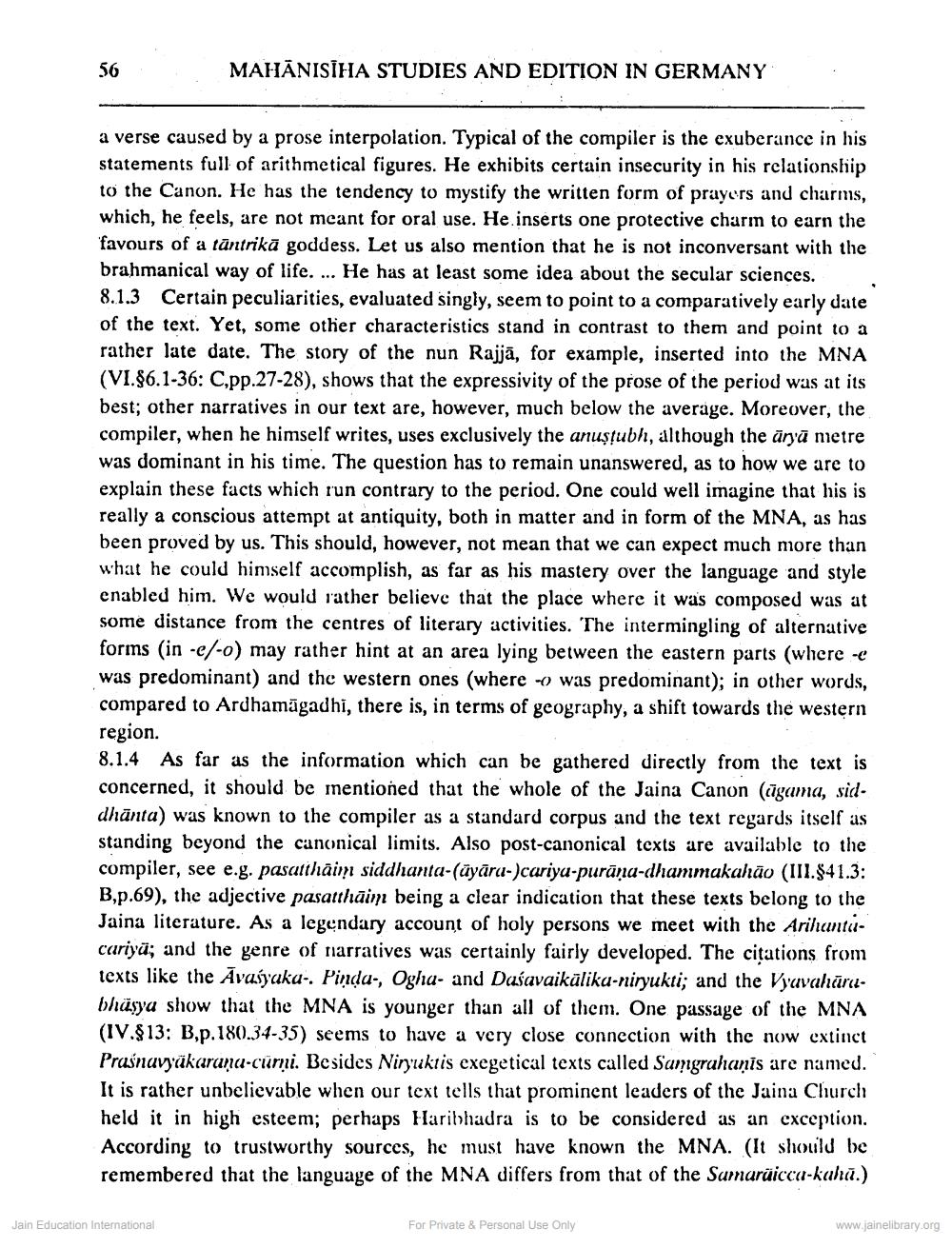________________
56
MAHĀNISIHA STUDIES AND EDITION IN GERMANY
a verse caused by a prose interpolation. Typical of the compiler is the exuberance in his statements full of arithmetical figures. He exhibits certain insecurity in his relationship to the Canon. He has the tendency to mystify the written form of prayers and charms, which, he feels, are not meant for oral use. He.inserts one protective charm to earn the favours of a tantrikā goddess. Let us also mention that he is not inconversant with the brahmanical way of life. ... He has at least some idea about the secular sciences. 8.1.3 Certain peculiarities, evaluated singly, seem to point to a comparatively early date of the text. Yet, some other characteristics stand in contrast to them and point to a rather late date. The story of the nun Rajjā, for example, inserted into the MNA (VI.86.1-36: C,pp.27-28), shows that the expressivity of the prose of the period was at its best; other narratives in our text are, however, much below the average. Moreover, the compiler, when he himself writes, uses exclusively the anuştubh, although the āņā metre was dominant in his time. The question has to remain unanswered, as to how we are to explain these facts which run contrary to the period. One could well imagine that his is really a conscious attempt at antiquity, both in matter and in form of the MNA, as has been proved by us. This should, however, not mean that we can expect much more than what he could himself accomplish, as far as his mastery over the language and style enabled him. We would rather believe that the place where it was composed was at some distance from the centres of literary activities. The intermingling of alternative forms (in -e/-o) may rather hint at an area lying between the eastern parts (where -e was predominant) and the western ones (where -() was predominant); in other words, compared to Ardhamägadhi, there is, in terms of geography, a shift towards the western region. 8.1.4 As far as the information which can be gathered directly from the text is concerned, it should be mentioned that the whole of the Jaina Canon (ūgama, sid. dhānta) was known to the compiler as a standard corpus and the text regards itself as standing beyond the canonical limits. Also post-canonical texts are available to the compiler, see e.g. pasatthāim siddhanta-(āyāru-)cariya-purāņa-dhammakahāo (III.841.3: B,p.69), the adjective pasatthāim being a clear indication that these texts belong to the Jaina literature. As a legendary account of holy persons we meet with the Arihantucariyü; and the genre of narratives was certainly fairly developed. The citations from texts like the Avaiyaku-. Pinda., Ogha- and Daśavaikäliku-niryukti; and the Vyavahūruzbhäsya show that the MNA is younger than all of them. One passage of the MNA (IV.813: B,p.180.34-35) seems to have a very close connection with the now extinct Prašnavyäkaruna-curņi. Besides Ninyuktis exegetical texts called Samgrahaņīs are named. It is rather unbelievable when our text tells that prominent leaders of the Jaina Church held it in high esteem; perhaps Haribhadra is to be considered as an exception. According to trustworthy sources, he must have known the MNA. (It should be remembered that the language of the MNA differs from that of the Samarüicca-kahā.)
Jain Education International
For Private & Personal Use Only
www.jainelibrary.org




